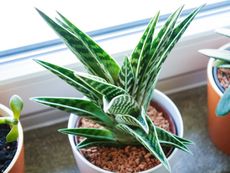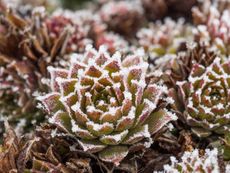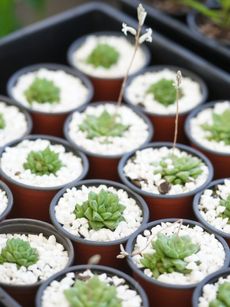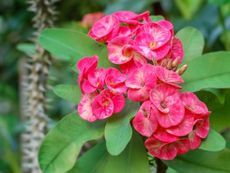Cactus Anthracnose Control: Tips For Treating Fungal Diseases In Cactus

Cacti seem to be hardy and fairly resistant to problems, but fungal diseases in cacti can be a major issue. An example of this is anthracnose fungus in cacti. Anthracnose on cacti can decimate an entire plant. Is there any effective cacti anthracnose control? Read on to find out about treating anthracnose in cacti.
Anthracnose on Cactus
Anthracnose is caused by a fungus (Colletotrichum spp.) and afflicts many plant species. Anthracnose fungus in cacti affects several types of cacti:
- Cereus
- Echinocactus
- Mammillaria
- Opuntia (prickly pear)
The first signs of infection are dark, water soaked lesions on stems, leaves, or fruit. Soon, the interior of the lesions becomes covered with a pink, jelly-like mass of spores. Within a few days of infection, the pink, gelatinous spores enlarge and eventually the plant tissue hardens and dries out. Agaves are also often afflicted, most often in the fall when the weather is wet. This fungal disease in cacti overwinters in and on seeds, soil and garden detritus. Wet, cool weather encourages development. Moist, warm temperatures of between 75 and 85 F. (24 and 29 C.) cause an increase in the growth of spores that are then spread via rain, wind, insects, and gardening tools.
Treating Anthracnose in Cactus
Once the plant is afflicted with anthracnose, there is no optimal cacti anthracnose control. Obviously, infected leaves (cladodes) can be removed but may not stop the progression of the infection. Use a knife that is disinfected before each cut. Disinfect by dipping the knife in one part bleach to four parts of water. In greenhouses, soil should be removed from areas of infected plants. All tools and pots need to be thoroughly disinfected. An application of copper fungicide, Maneb, Benomyl, or Dithane may aid in destroying any remaining fungi. Be sure to completely destroy any infected parts or complete plants so they do not infect other areas. Practice good garden sanitation by removing any rotting plant debris immediately. Water plants at the base to avoid splashing and spreading spores. Keep tools disinfected.
Gardening tips, videos, info and more delivered right to your inbox!
Sign up for the Gardening Know How newsletter today and receive a free download of our most popular eBook "How to Grow Delicious Tomatoes."

Amy Grant has been gardening for 30 years and writing for 15. A professional chef and caterer, Amy's area of expertise is culinary gardening.
-
 10 Best Apartment Plants To Turn Your Small Space Into An Oasis
10 Best Apartment Plants To Turn Your Small Space Into An OasisThe best apartment plants can lend an ambience of the tropics, brighten up a space, or add a touch of drama, and turn an apartment into a relaxing oasis.
By Amy Grant
-
 Grow a Bathroom Oasis: 8 Best Bathroom Plants With No Light or Low Light
Grow a Bathroom Oasis: 8 Best Bathroom Plants With No Light or Low LightSome apartment dwellers grow the best bathroom plants with no light or low light. Read how one of our favorite plant lovers does it in the big city.
By Teo Spengler
-
 Variegated Succulents To Add To Your Plant Collection
Variegated Succulents To Add To Your Plant CollectionRead about some of the pretty variegated species that add beauty and interest to your succulent collection.
By Becca Badgett
-
 How To Protect Succulents And Cacti From Rain
How To Protect Succulents And Cacti From RainRain has the potential to cause damage to our cacti and succulents. However, when planted in proper soil, rainfall may perform as just a deep watering. Read on for more.
By Becca Badgett
-
 Succulents and Frost: How To Save A Succulent From Frost Or Freeze
Succulents and Frost: How To Save A Succulent From Frost Or FreezeCan succulents withstand cold? Succulents and frost don't traditionally go together and can result in damage, but you may be able to save frozen succulents.
By Bonnie L. Grant
-
 Pink Succulents Varieties To Try: How To Grow Perfect Pink Succulent Plants
Pink Succulents Varieties To Try: How To Grow Perfect Pink Succulent PlantsPink succulents may display the color on leaf edges or with streaks or blotches mingled throughout the foliage. Here are our favorites.
By Becca Badgett
-
 10 No Fuss Cacti - What’s The Best Low Maintenance Cactus
10 No Fuss Cacti - What’s The Best Low Maintenance CactusIf you’re thinking of adding plants to your collection, consider no fuss cacti. Click here for an easy cacti list, even for beginners.
By Becca Badgett
-
 5 Best Succulents For A Bathroom
5 Best Succulents For A BathroomSome succulents can be great options for bathroom decoration. Read on for our top five bathroom succulent ideas.
By Becca Badgett
-
 What Is A Succulent Starter Kit - Best Succulent Starter Kits
What Is A Succulent Starter Kit - Best Succulent Starter KitsWhile garden kits are not the most inexpensive option for growing succulents, they do include everything you’ll need. Grow succulents from seed by using a succulent seed starter kit to learn the process and to check your results.
By Becca Badgett
-
 Dazzling Succulents - Succulents With Striking Flowers
Dazzling Succulents - Succulents With Striking FlowersWhen you think of succulents you may just envision their unique leaves and stems. But succulents also produce bright and bold flowers in the right conditions. Read on to learn more.
By Bonnie L. Grant